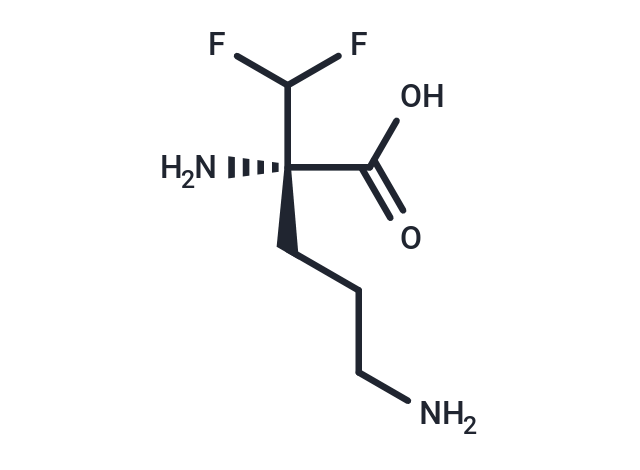Shopping Cart
- Remove All
 Your shopping cart is currently empty
Your shopping cart is currently empty

L-Eflornithine is an irreversible ornithine decarboxylase (ODC) inhibitor with a KD of 1.3±0.3 μM, and a Kinact of 0.15±0.03 min-1. L-Eflornithine is an enantiomer of Eflornithine.

| Pack Size | Price | Availability | Quantity |
|---|---|---|---|
| 25 mg | $1,520 | 6-8 weeks | |
| 50 mg | $1,980 | 6-8 weeks | |
| 100 mg | $2,500 | 6-8 weeks |
| Description | L-Eflornithine is an irreversible ornithine decarboxylase (ODC) inhibitor with a KD of 1.3±0.3 μM, and a Kinact of 0.15±0.03 min-1. L-Eflornithine is an enantiomer of Eflornithine. |
| Targets&IC50 | Ornithine decarboxylase,ODC:(kd)1.3±0.3 µM |
| In vitro | Treatment of human colon tumour-derived HCT116 cells with either L-Eflornithine or D- Eflornithine decreases the cellular polyamine contents in a concentration-dependent manner. The enantiomers display different potencies in vitro, with the L-enantiomer having up to a 20-fold higher affinity for the target enzyme ornithine decarboxylase. ?The L-Eflornithine also appears to be more potent in cultured T.brucei gambiense parasites.?Eflornithine ?is an inhibitor of ODC, the first enzyme in eukaryotic polyamine biosynthesis.?Both enantiomers of Eflornithine ?irreversibly inactivate ODC.?Both Eflornithine enantiomers ?suppress ODC activity in a time- and concentration-dependent manner.?The inhibitor dissociation constant (KD) values for the formation of enzyme-inhibitor complexes are 28.3±3.4, 1.3±0.3 and 2.2±0.4 μM respectively for D-Eflornithine, L-Eflornithine and Eflornithine.?The inhibitor inactivation constants (Kinact) for the irreversible step were 0.25±0.03, 0.15±0.03 and 0.15±0.03 min-1 respectively for D-Eflornithine, L-Eflornithine and Eflornithine. |
| In vivo | The typical oral clearances for L-Eflornithine and D-eflornithine are 17.4 and 8.23 liters/hour, respectively. Despite L-Eflornithine being the more potent form, it is found in significantly lower concentrations in both plasma and cerebrospinal fluid (CSF) compared to D-Eflornithine. On average, plasma concentrations of L-Eflornithine are 52% of those found for the D-enantiomer. |
| Alias | L-α-difluoromethylornithine, L-RMI71782, L-DFMO |
| Molecular Weight | 182.17 |
| Formula | C6H12F2N2O2 |
| Cas No. | 66640-93-5 |
| Relative Density. | 1.293 g/cm3 (Predicted) |
| Storage | Powder: -20°C for 3 years | In solvent: -80°C for 1 year | Shipping with blue ice. |

Copyright © 2015-2024 TargetMol Chemicals Inc. All Rights Reserved.